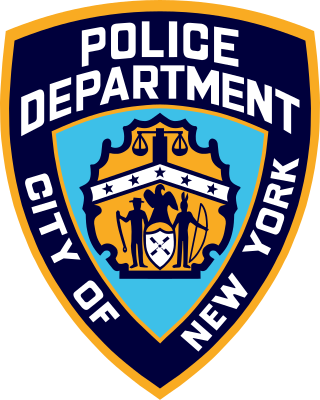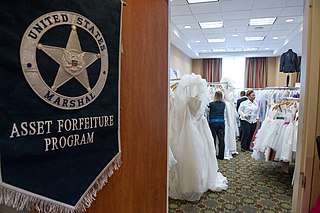
The Fourth Amendment to the United States Constitution is part of the Bill of Rights. It prohibits unreasonable searches and seizures. In addition, it sets requirements for issuing warrants: warrants must be issued by a judge or magistrate, justified by probable cause, supported by oath or affirmation, and must particularly describe the place to be searched and the persons or things to be seized.
A search warrant is a court order that a magistrate or judge issues to authorize law enforcement officers to conduct a search of a person, location, or vehicle for evidence of a crime and to confiscate any evidence they find. In most countries, a search warrant cannot be issued in aid of civil process.
An arrest warrant is a warrant issued by a judge or magistrate on behalf of the state, which authorizes the arrest and detention of an individual, or the search and seizure of an individual's property.

The New York City Police Department (NYPD), officially the City of New York Police Department, is the primary municipal law enforcement agency within the City of New York. Established on May 23, 1845, the NYPD is the largest, and one of the oldest, municipal police departments in the United States.

Search and seizure is a procedure used in many civil law and common law legal systems by which police or other authorities and their agents, who, suspecting that a crime has been committed, commence a search of a person's property and confiscate any relevant evidence found in connection to the crime.
In rem jurisdiction is a legal term describing the power a court may exercise over property or a "status" against a person over whom the court does not have in personam jurisdiction. Jurisdiction in rem assumes the property or status is the primary object of the action, rather than personal liabilities not necessarily associated with the property.

The Criminal Court of the City of New York is a court of the State Unified Court System in New York City that handles misdemeanors and lesser offenses, and also conducts arraignments and preliminary hearings in felony cases.
Section 8 of the Canadian Charter of Rights and Freedoms protects against unreasonable search and seizure. This right provides those in Canada with their primary source of constitutionally enforced privacy rights against unreasonable intrusion from the state. Typically, this protects personal information that can be obtained through searching someone in pat-down, entering someone's property or surveillance.

Asset forfeiture or asset seizure is a form of confiscation of assets by the authorities. In the United States, it is a type of criminal-justice financial obligation. It typically applies to the alleged proceeds or instruments of crime. This applies, but is not limited, to terrorist activities, drug-related crimes, and other criminal and even civil offenses. Some jurisdictions specifically use the term "confiscation" instead of forfeiture. The alleged purpose of asset forfeiture is to disrupt criminal activity by confiscating assets that potentially could have been beneficial to the individual or organization.

The New York City Taxi and Limousine Commission is an agency of the New York City government that licenses and regulates the medallion taxis and for-hire vehicle industries, including app-based companies such as Uber and Lyft. The TLC's regulatory landscape includes medallion (yellow) taxicabs, green or Boro taxicabs, black cars, community-based livery cars, commuter vans, paratransit vehicles (ambulettes), and some luxury limousines.

The Fifth Amendment to the United States Constitution creates several constitutional rights, limiting governmental powers regarding both criminal procedure and civil matters. It was ratified, along with nine other articles, in 1791 as part of the Bill of Rights. The Fifth Amendment applies to every level of the government, including the federal, state, and local levels, in regard to any "person". The Supreme Court furthered the protections of this amendment through the Due Process Clause of the Fourteenth Amendment.

The New York City Sheriff's Office (NYCSO), officially the Office of the Sheriff of the City of New York, is the primary civil law enforcement agency for New York City. The Sheriff's Office is a division of the New York City Department of Finance, operating as an enforcement arm. The Sheriff's Office handles investigations concerning cigarette tax enforcement, real estate property/deed fraud and other matters deemed necessary by the Department of Finance.
Quantity of Books v. Kansas, 378 U.S. 205 (1964), is an in rem United States Supreme Court decision on First Amendment questions relating to the forfeiture of obscene material. By a 7–2 margin, the Court held that a seizure of the books was unconstitutional, since no hearing had been held on whether the books were obscene, and it reversed a Kansas Supreme Court decision that upheld the seizure.
Alvarez v. Smith, 558 U.S. 87 (2009), was a United States Supreme Court decision on seizure of property by the Chicago Police Department, however the case was declared moot by the Court as the parties agreed that there was no longer contention over the property seized.

Civil forfeiture in the United States, also called civil asset forfeiture or civil judicial forfeiture, is a process in which law enforcement officers take assets from people who are suspected of involvement with crime or illegal activity without necessarily charging the owners with wrongdoing. While civil procedure, as opposed to criminal procedure, generally involves a dispute between two private citizens, civil forfeiture involves a dispute between law enforcement and property such as a pile of cash or a house or a boat, such that the thing is suspected of being involved in a crime. To get back the seized property, owners must prove it was not involved in criminal activity. Sometimes it can mean a threat to seize property as well as the act of seizure itself. Civil forfeiture is not considered to be an example of a criminal justice financial obligation.
The New York City Office of Administrative Trials and Hearings (OATH) is an administrative office of the New York City government. It is a non-mayoral executive agency and is not part of the state Unified Court System.
Timbs v. Indiana, 586 U.S. ___ (2019), was a United States Supreme Court case in which the Court dealt with the applicability of the excessive fines clause of the Constitution's Eighth Amendment to state and local governments in the context of asset forfeiture.
United States v. 422 Casks of Wine, 26 U.S. 547 (1828), is an 1828 United States Supreme Court civil forfeiture case between the United States and 422 casks of Malaga wine. The case was brought after the United States moved to seize the wine on the grounds that it had been deliberately mislabeled as sherry to get a tax drawback, and the buyers objected. The original trial was ruled in favor of the United States but was ordered to be retried after errors were discovered concerning jurisdiction. In the subsequent retrial, the Supreme Court ruled against the United States; however, they did grant them a certificate of seizure on probable cause.
South Dakota v. Fifteen Impounded Cats, 785 N.W.2d 272, is a 2010 Supreme Court of South Dakota civil forfeiture case brought by the American state of South Dakota against fifteen cats that they had seized on the grounds of interfering with a driver's visibility. The seizure was challenged by the owner of the cats and the court found on a 3–2 majority that the seizure was lawful because of the risk to pedestrians as well as to the cats.
Nebraska v. One 1970 2-Door Sedan Rambler (Gremlin) 191 Neb. 462, 215 N.W.2d 849 (1974) is a Nebraska Supreme Court civil forfeiture case. It was brought by the American state of Nebraska to seize a Rambler Gremlin on the sole grounds it was transporting illegal marijuana. The owner appealed against the forfeiture decision on the grounds of a claimed lack of due process. The court ruled 4–2 and sustained the confiscation as lawful.








